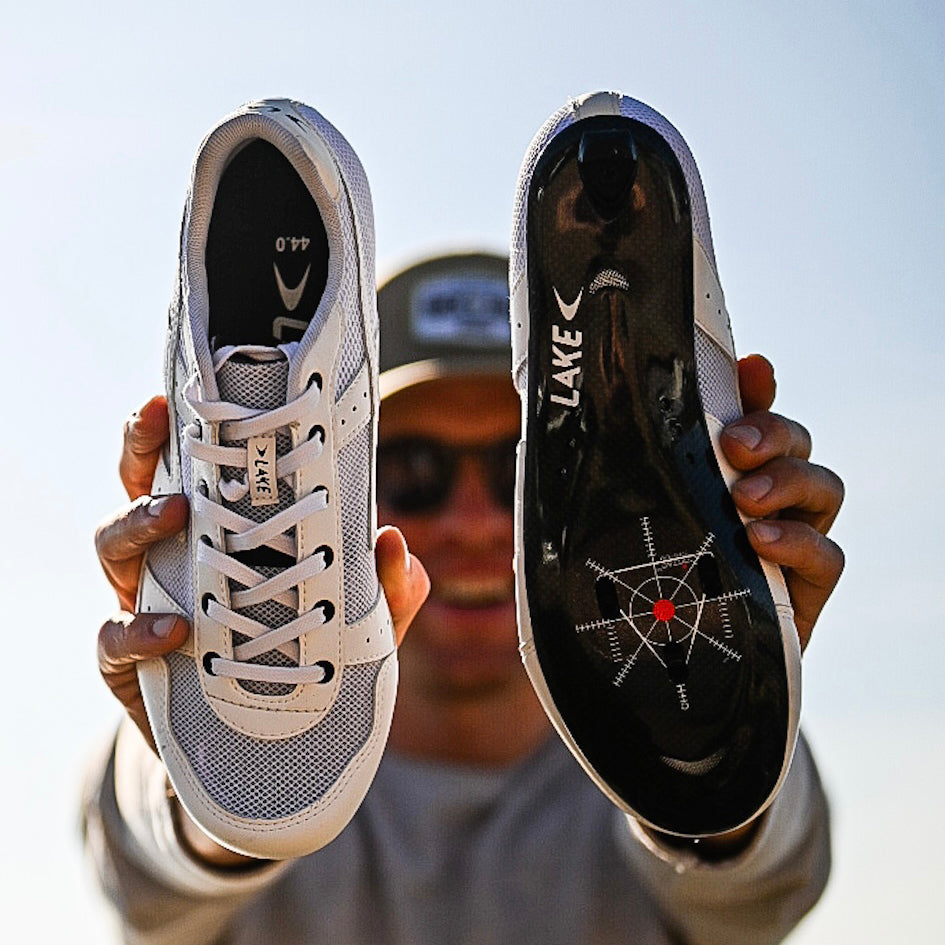Degenen onder ons die clipless pedalen gebruiken, hebben wel eens meegemaakt hoe ingewikkeld het is om zichzelf op de juiste manier los te maken van de fiets. Jaren geleden, toen ik ze voor het eerst gebruikte, kon ik niet op tijd loskomen en viel ik in een heg - tot groot vermaak van mijn medefietsers! Het is een veel voorkomend thema bij fietsclubs, wanneer de groep stopt voor verkeerslichten en kijkt wie er omvalt voordat de groep kan worden losgekoppeld. Er zijn echter veel voordelen verbonden aan het rijden zonder clips; daarom produceren we bij Lake fietsschoenen waarmee renners dit kunnen doen.
De voor de hand liggende voordelen van clipless rijden zijn de stabiliteit van de voet en de krachtoverbrenging. Het rijden op platte pedalen is een geweldige manier om de fiets te leren beheersen, vooral bij mountainbiken. Maar elke keer dat de fiets een hobbel raakt, en bij vele andere gelegenheden wanneer de voet loskomt van het pedaal, verlies je die waardevolle controle en kracht. In termen van krachtoverbrenging, wanneer de voet op een vlak pedaal het pedaal naar beneden heeft geduwd, wordt het bijna overbodig om de crank weer omhoog te duwen om de beweging voort te zetten. Er gaat vitale kracht verloren, zelfs als je pedaalactie op vlakke stukken uitstekend is. Het pedaal en de voet zijn eenvoudigweg niet volledig met elkaar verbonden.

Zetten van de schoenplaatjes
Met name op racefietsen biedt het gebruik van clipless pedalen racefietsers de extra controle en kracht die ze nodig hebben. De juiste afstelling van de pedalen en schoenplaatjes is echter van vitaal belang. Als je erover nadenkt, zit het pedaal vast aan de voet; de voet zit vast aan het been en de knie; en de knie zit vast aan het bovenbeen en de heupen. Er kunnen veel problemen ontstaan langs deze keten als de pedalen en schoenplaatjes niet zijn ingesteld op je eigenindividuele behoeften. Op elk van deze punten kun je pijn of ongemak voelen.
Onze individualiteit is overduidelijk als we lopen. Onze voeten kunnen in verschillende richtingen wijzen, al is het maar een fractie. Hoe onze linker- en rechtervoet van nature werken, is belangrijk wanneer we deze voeten op de pedalen vastzetten met schoenplaatjes. Daarom worden schoenplaatjes geleverd met verschillende zweefstandopties en met vulringen - om u te helpen de juiste schoenplaatpositie en zweefstand te vinden voor uw eigen fietsbehoeften. Hierdoor verkleint u de kans op pijn en ongemak langs de enkel-, knie- en heupketting tijdens het rijden.
Fundamenteel zijn er vijf manieren waarop u uw schoenplaatjes kunt afstellen: voorwaarts en achterwaarts, zijwaarts, rotatie, met behulp van de zweefstand en tot slot de pedaalspanning. Een kleine mate van float is altijd nuttig voor fietsers, omdat je knieën dan op een natuurlijke manier kunnen buigen en strekken tijdens het trappen. Fabrikanten bieden schoenplaatjes aan met verschillende mate van zweefkracht. Bezoek een fietsfittingexpert bij een van onze Lake shoe fitting partners om erachter te komen welke mate van zweefkracht u nodig hebt.
Een goed begrip van de zweefstand is essentieel om comfortabel te kunnen fietsen; een goede en nauwkeurigezweefstand van de schoenplaat zorgt voor een kleine mate van beweging tijdens het trappen, waardoordebelasting op uw gewrichten kan worden verminderd. De fietsfitter werkt met u samen om ervoor te zorgen dat de rotatie wordt ingesteld op zodat uw voeten zich in een natuurlijke positie bevinden wanneer u op de fiets bent vastgeklikt.De juiste instelling zorgt voor kilometers glimlach op de fiets, dus eenprofessionele Bike Fit is de investering waard.

Baten van een fietsfitting
De juiste positie van uw fietsschoenplaatjes ten opzichte van de pedalen is van cruciaal belang , zoals we al hebben aangegeven. De fietsfittingexperts die met Lake samenwerken, controleren alle noodzakelijke punten voor je. deschoen moet echter zo worden geplaatst dat het midden van de pedaalas op één lijn ligt met de bal van je voet (de middenvoetsbeenkoppen). Dit moethelpen om de krachtoverbrenging te optimaliseren en de belasting te verminderen.
In principe ontwerpen we fietsschoenen om je het nodige comfort en de nodige prestaties op de fiets te geven. Als uw schoenplaatjes echter niet goed zijn afgesteld voor uw eigen behoeften, moet u de schoenplaatjes wellicht aanpassen. U gebruikt misschien al enige tijd, zelfs al vele jaren, clipless pedalen. Heb je echter ooit de tijd genomen om in detail na te denken over hoe de schoenplaatjes op de zool van je Lake fietsschoenen worden geplaatst? Zo niet, dan is het zeer waarschijnlijk dat een bezoek aan een Lake shoes, bike fitting partner je zal helpen om alles correct in te stellen, waardoor de kans op problemen kleiner wordt en je prestaties en efficiëntie op de fiets toenemen. Klik hier voor meer informatie over het monteren van schoenplaatjes op je nieuwe paar Lake fietsschoenen: https://www.lakecycling.com/pages/cleat-installation


Een zomer van sport in de hele wielerwereld
Een zomer van sport in de hele wielerwereld